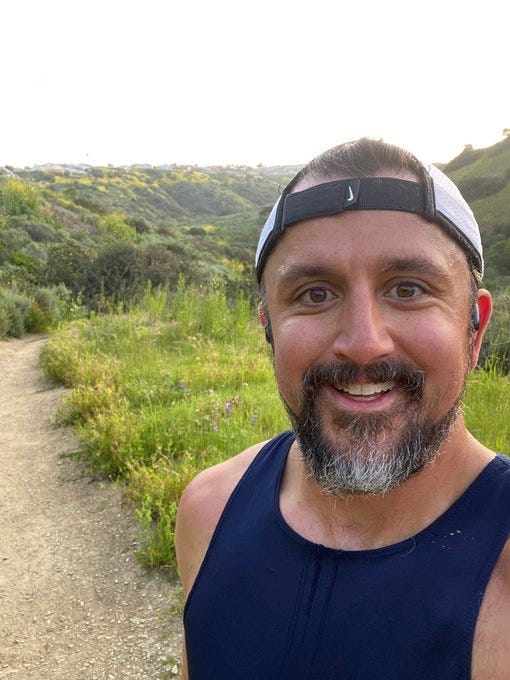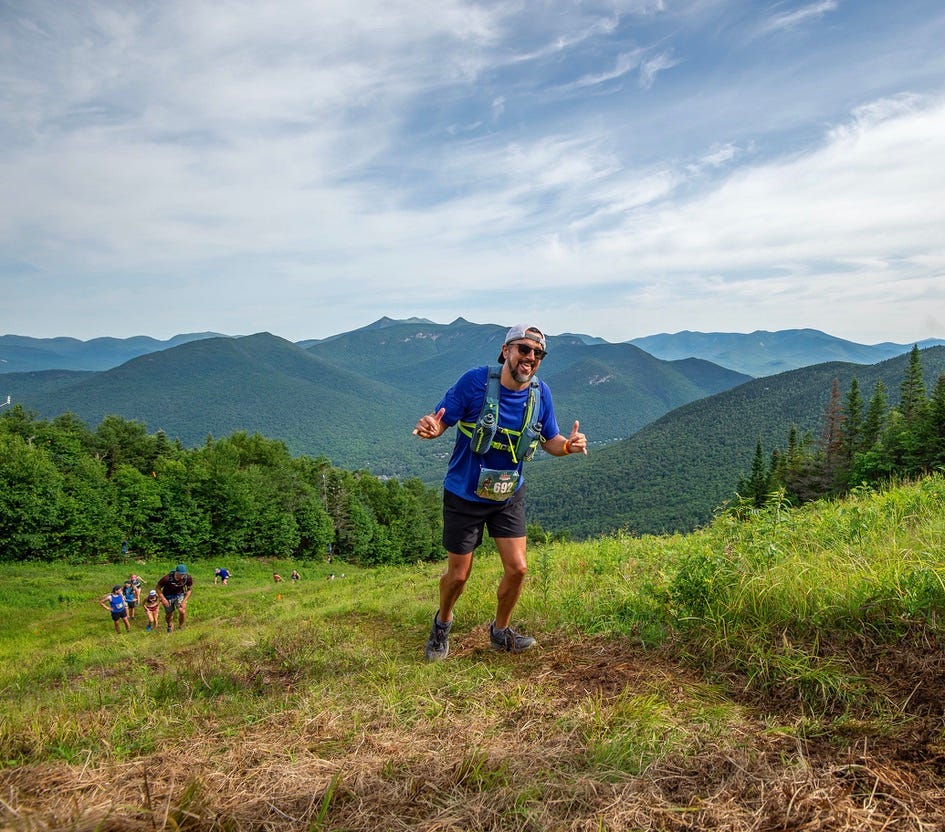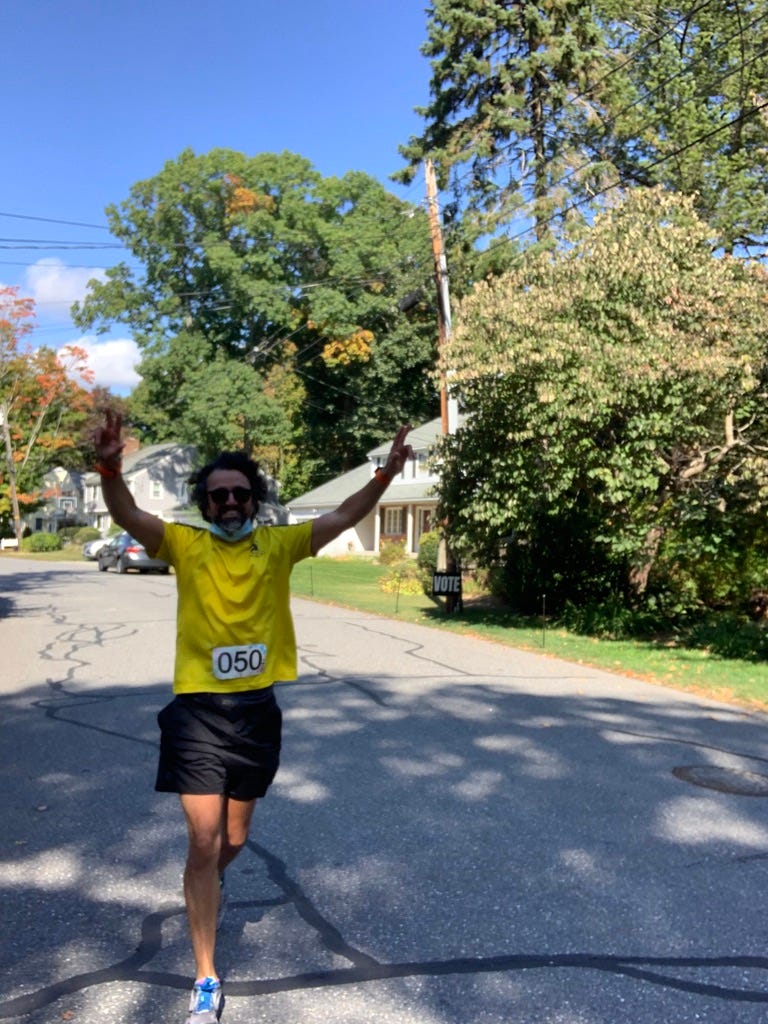How Jeremy Singh went from overweight dad to ultra runner - and 40,000 Twitter followers
The #goforarun influencer is aiming to complete a 100-mile race in October
In a little over three months, Jeremy Singh will take on a challenge he once “couldn’t even fathom”.
The Massachusetts resident is set to run 100 miles at the Ghost Train ultra on October 14-15.
For Jeremy, it is the latest in a series of challenges which has seen him go from overweight dad to six-time ultra marathoner.
Along the way he has built a 40,000-strong Twitter following by posting running tips and strength training videos.
Jeremy, who said he has come a long way from unhealthy days of ‘packing on fat’ and making ‘classic running mistakes,’ has built up from an original marathon goal to a 75 mile race last year.
Taking on 100 miles would see him complete a challenge he once saw as, if not impossible, then the preserve of elite ultra runners.
‘Discovering slowing down’:


When he was younger, Jeremy played baseball and took part in sprint distances on the track.
But although he continued to go to the gym as he got older, he stopped doing any cardio.
“I was drinking a lot, eating really unhealthy food and just packing on some muscle but a lot of fat too,” he said.
“It took until about seven years ago, that I started to wake up and realise that if I continued down that track it would lead to bad outcomes.”
Jeremy’s family has a history of heart disease - and of combating it through the power of running.
His dad had a heart attack when Jeremy was only five years old, but recovered to take part in several marathons.
“I like to say he went from hospital bed to marathon finish line,” Jeremy said.
“So that seed was planted back when I was a kid watching him go on training runs and complete marathons. I would ride my bike with him on a lot of his training runs.
“I knew I always wanted to run a marathon.”
Despite having set his marathon goal, Jeremy’s progress was hindered by what he calls “the classic running mistakes”.
He said: “I would start with a big burst of energy, thinking I would train hard and would be able to check this box of running a marathon.
“I would run really hard every day, push it harder and harder, and faster and faster, and every time it was shin splints or being burnt out or whatever it was that brought me back to the couch.”
It wasn’t until he reached 35 that he listed to his dad’s very simple advice on long-distance running: ‘Slow down’.
“That year I went 100 per cent slow. I didn’t do any interval training or anything like that.
“I was just listening to my body, paying attention to my breathing, trying to breath through my nose, and then looking at my heart rate zones and just saying if I hit a hill and it’s getting harder, then I’m going to walk.
“That was the first time I was able to run and not get injured, and very gradually go the distance.”
#goforarun - Becoming a Twitter sensation:
Jeremy Singh’s “wild experience” on Twitter started as a marketing ploy for a potential book about running.
It’s grown to an audience of more than 40,000 followers to his @singhcredible feed and demand for t-shirts boasting his catchphrase '#goforarun”.
“I thought why don’t I see if I can develop an audience online,” he said. “I was writing on Twitter and LinkedIn, and on Twitter I lucked into this gap in the market where there wasn’t a lot of running content.
“I follow a lot of accomplished, elite runners but they can be hard to relate to. They’ve been doing it their whole lives and are doing it at such a high level that very few people are going to reach, whereas I’m definitely not winning any races or anything like that.
“If you want to do what I’m doing, you can do it. It might take a few years to get to where I’m at now, but anybody can do this. I think I’m a little bit more relatable.
“On Twitter, people say I’m more of a guy than a guru.”
Jeremy posts threads full of in-depth tips on everything from strength training and the benefits of running slowly to training plans and motivational mantras.
His feed is also scattered with workout videos as well as often tongue-in-cheek two or three line tweets encouraging people to #goforarun.
He said: “I paused the book and just focused on building the audience.
“I post these tweets which are a line and then #goforarun and that has become a catchphrase.
“People were asking ‘when are you going to put that on a t-shirt and sell it’.”
Jeremy told the Running Tales Podcast the early mistakes he made are all too common.
“A lot of people think I’m going to start running and I need to get a good workout,” he said. “I need to be that sweating, slobbering mess at the end of a run every time.
“You just can’t maintain that. Running is just too hard on your body. It takes a really long time to be able to adapt and grow strong.
“Your fitness will increase faster than your bodies ability to withstand the impact. That’s what leads to that breakdown.”
Upping the distance:
Jeremy’s running career started to go into overdrive and after tackling the half-marathon distance, he was “finally able to get my marathon”.
That first 26.2-mile race was the 2018 Baystate Marathon, close to Jeremy’s home near Boston, Massachusetts - and it was every bit as life-affirming as he had hoped it would be.
One highlight came at mile 17 when he saw his wife and children: “I picked up my younger daughter for a hug and it was the most energy boosting high. The few miles after that were some of the fastest miles I ran that day.
“I had a profound sense of pride and gratitude that I had finally achieved this goal that I had wanted to do for so long.”
It is that sense of achievement which has spurred Jeremy to run longer and longer distances, along with a dollop of sibling rivalry.
Also on Running Tales
Start with “stupid” and end in success… What does it take to complete a 145-mile race?
From marathons to best selling books - how running changed Hannah Phillips' life
Running to show the humanity behind every blanket - the story behind the 16:15 Charity Run
‘Born to run’:
He told Running Tales he was first inspired by the stories of ultra marathoners in ‘Born to Run,’ the book which has become many a long-distance runner’s Bible.
When he first read Christopher McDougall’s take on the mysterious tribe of Mexican Indians, the Tarahumara, Jeremy didn’t think running for a hundred miles was realistic for everyday runners.
“It just seemed like this crazy idea that someone could even run 100 miles,” he said.
“I couldn’t even fathom what that would be like.”
But pushed on by his marathon success - “part of me thinks that running further and further is chasing that feeling again” - and the increase in popularity and accessibility of ultra running, he set himself a goal to complete a 100 mile run.
If the goal seems lofty - and it is - it also owes a little something to straight-up sibling rivalry.
“I’m a little bit competitive,” Jeremy said, “My brother was a great runner in high school and college.
“He used to win half-marathons, and my dad ran several marathons. Once I got that marathon, I thought I’m not going to beat them on speed, but I’m going to go further.”
Jeremy formed a plan to increase his mileage, taking part in one gut-busting ultra every year - each going further than the previous one.
The Baystate Marathon was followed by a 50k in 2019. In 2020, he ran 50 miles and the following year took on 60.
Jeremy’s original plan was to tackle the 100-mile distance last year, but he felt he needed another step in the journey so instead completed a 75-mile race.
All of which has set him up to take on the Ghost Train ultra in October. The seven-and-a-half mile out and back course allows competitors to run for as far as they want to over 30 hours.
It is a goal and journey Jeremy said has not only helped him physically, but has seen him develop skills to take on adversity in everyday life.
He said: “At 100 miles or some of these crazy distances, you are putting yourself at risk. This might not be the healthiest thing for your body.
“But it does build your mind and your mental toughness because you are going to get to a place where you don’t want to go any more. You are going to want to stop.
“After my 75 mile race I remember the last 20 miles or so was mostly walking, and all I could think about was how much I wanted to be done, but the only way I was going to get done was to keep moving forward.
“It prepares you for a lot of things in life. Things aren’t always going to go your way. Bad things are going to happen at some point. To develop your mind in that way, to me that’s preparing myself for that.
“I love pushing myself and seeing what I’m capable of.”
Thanks as ever for reading and listening to Running Tales. We couldn’t do this without your support - please back us to keep going by…









